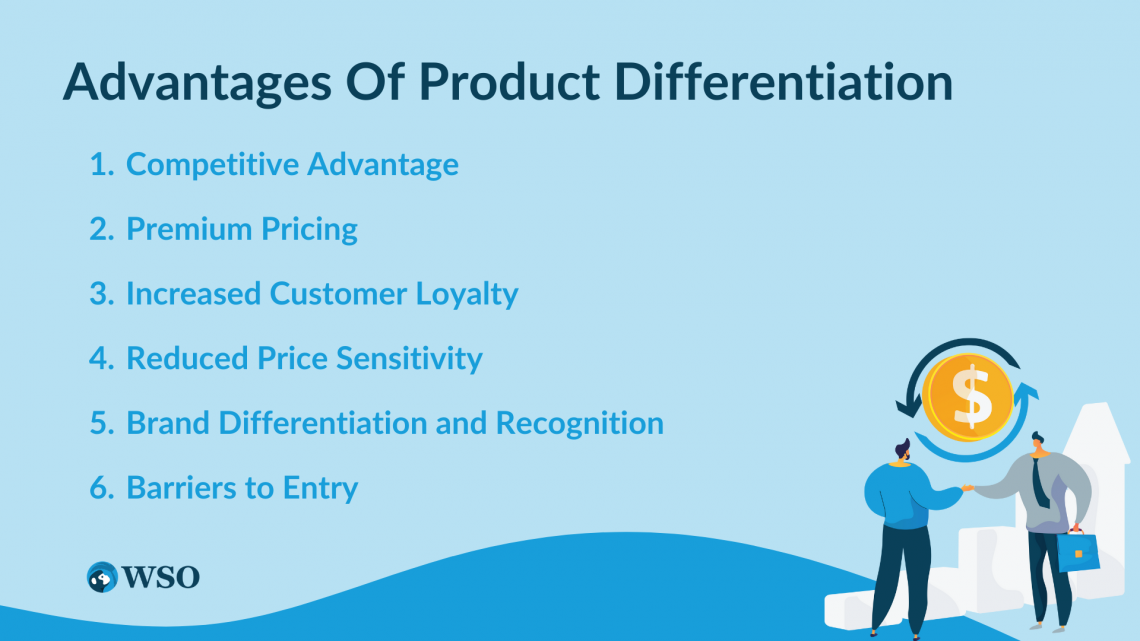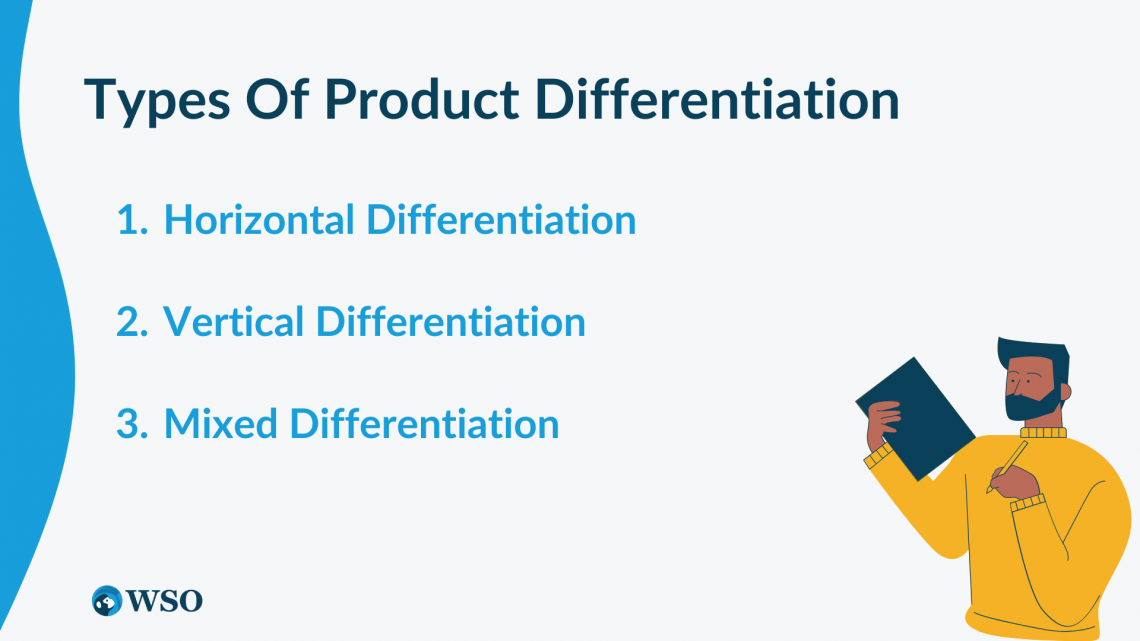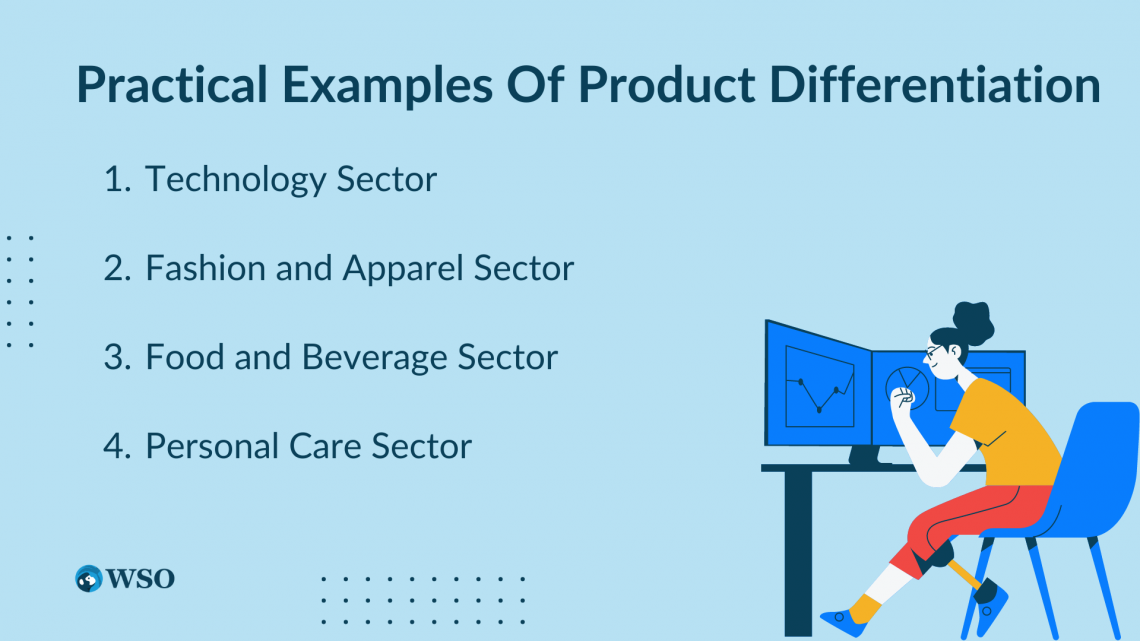Product Differentiation
It is the process of creating unique features, attributes, or qualities that add value and appeal to customers.
Product differentiation is a marketing method that creates specific traits, functions, or qualities for a product or service to distinguish it from market competition.

It is the process of highlighting and promoting the unique selling points of a product to attract customers and gain a competitive advantage. Product differentiation aims to create a perception of added value and superiority in the minds of consumers.
This differentiation can be achieved through various means, such as:
- Physical attributes
- Features and functionalities
- Superior customer service
- Effective branding and positioning
It helps create a perception of added value and superiority in the minds of consumers, allowing companies to command premium pricing, build customer loyalty, and target specific customer segments effectively.
It can be measured through various indicators such as:
- Market share
- Customer perception surveys
- Sales growth
- Pricing power
- Customer loyalty
- Brand recognition
These metrics reflect the success of a product's unique features, attributes, or qualities in setting it apart from competitors and attracting customers.

Achieving product differentiation requires a collaborative effort from multiple teams within an organization. The marketing team plays a crucial role in understanding customer needs, conducting market research, and identifying opportunities for differentiation.
The R&D team develops unique features. The design team contributes to creating visually appealing and distinctive product aesthetics. The sales team effectively communicates the product's unique selling points to customers.
Finally, the customer service team armed with modern contact center tech delivers superior post-purchase support and service, enhancing the overall differentiation experience.
Key Takeaways
- Product differentiation is the process of creating unique features, attributes, or qualities that add value and appeal to customers.
- Differentiation can be achieved through physical attributes, features, functionalities, service excellence, or branding and positioning.
- Effective product differentiation helps attract customers, gain a competitive advantage, and justify premium pricing.
- Metrics such as market share, customer perception, sales growth, pricing power, customer loyalty, and brand recognition can be used to measure the success of product differentiation.
Advantages of Product Differentiation
It offers several advantages for businesses in competitive markets. Here are some key advantages:

1. Competitive Advantage
Effective product differentiation allows a company to stand out from competitors and gain a competitive edge. By offering unique features or attributes valuable to customers, a company can create a perception of superiority and attract a loyal customer base.
This can lead to increased market share and reduced vulnerability to price-based competition.
2. Premium Pricing
When a product is differentiated successfully, customers perceive it as adding value and are often willing to pay a premium price.
NOTE
Differentiated products can command higher prices than generic or undifferentiated alternatives, resulting in increased profit margins and improved financial performance for the company.
3. Increased Customer Loyalty
It helps foster customer loyalty and reduces the likelihood of customers switching to competing brands. This can lead to long-term customer relationships and higher customer lifetime value.
4. Reduced Price Sensitivity
Differentiated products are often less price-sensitive compared to generic or commodity products. With unique features in a product, customers would easily get ready to pay a high price.
NOTE
Unique features reduce the impact of price fluctuations or discounting strategies on the company's revenue and profitability.
5. Brand Differentiation and Recognition
It contributes to building a strong brand image and identity. Unique features and attributes create a distinct brand personality and position the product as the preferred choice in the market.
NOTE
Brand Differentiation helps establish brand recognition, brand equity, and a competitive advantage that sets the company apart from competitors.
Successful product differentiation can create barriers to entry for new competitors. If a company has established a strong brand image and customer loyalty through differentiated products, it becomes more challenging for new entrants to replicate those qualities and compete effectively.
This can provide a level of protection and sustainability for the company's market position.
Types of Product Differentiation
Horizontal, vertical, and mixed differentiation are the three types of product differentiation. Each type focuses on different product or service aspects to create uniqueness and appeal to customers.

1. Horizontal Differentiation
Horizontal differentiation refers to creating unique features or attributes that set a product apart from competitors within the same market segment.
It aims to cater to diverse customer preferences by offering options with different qualities or characteristics. The goal is to create a perceived difference without necessarily being objectively better or worse than competitors.
Example
In the smartphone market, different brands may offer devices with varying camera capabilities, display sizes, or design aesthetics to target different consumer preferences.
2. Vertical Differentiation
Vertical differentiation focuses on creating a clear hierarchy of quality or performance among competing products. It involves offering products with superior or inferior attributes compared to competitors.
The aim is to position the product as either premium or budget-oriented, catering to different market segments. Vertical differentiation can be based on factors such as functionality, performance, durability, materials used, or technological advancements.
Example
Luxury car companies distinguish themselves within the automotive sector by providing premium amenities, exceptional craftsmanship, and cutting-edge technology. In contrast, budget car brands place a higher priority on affordability and fuel efficiency.
Vertical differentiation relies on creating a perceived superiority or inferiority based on objective attributes to target specific customer segments.
3. Mixed Differentiation
Mixed differentiation is a combination of horizontal and vertical differentiation. It involves creating unique features or attributes that appeal to different customer preferences while incorporating a hierarchy of quality or performance.
Mixed differentiation allows companies to cater to diverse customer segments within the market. To cater to various customer needs, this strategy offers various items with differing degrees of quality, features, or price points.
Example
In the laptop industry, a business might provide various products with various processor speeds, storage capacities, and screen sizes to appeal to price-conscious consumers and those looking for high-performance devices.
Mixed differentiation leverages horizontal and vertical elements to capture a broader customer base.
Practical Examples of Product Differentiation
Product differentiation can be observed across various sectors as businesses strive to create unique and compelling offerings. Here are practical examples of it from different sectors:

1. Technology Sector
Apple's iPhone stands out in the smartphone market due to its unique features, design, and user experience. The seamless hardware and software integration and the exclusive iOS ecosystem set it apart from competitors.
Apple's emphasis on aesthetics and premium materials also contributes to its product differentiation strategy.
2. Fashion and Apparel Sector
Luxury fashion brands like Gucci differentiate themselves through their brand image, craftsmanship, and exclusive designs. To convey a sense of exclusivity and desirability to customers, these businesses frequently use premium materials, elaborate detailing, and small batch sizes.
NOTE
The branding and perceived prestige associated with luxury fashion products differentiate them from mass-market alternatives.
3. Food and Beverage Sector
Starbucks has successfully differentiated itself in the coffee industry by offering a unique customer experience. Starbucks has created a distinct brand identity with its cozy and inviting store ambiance, personalized beverage options, and a range of food choices.
NOTE
The company's focus on creating a third-place experience beyond home and work has set it apart from traditional coffee chains.
4. Personal Care Sector
Dove differentiates its beauty products by emphasizing a message of body positivity and inclusivity. Through its "Real Beauty" campaign, Dove has created a unique positioning that celebrates diversity and challenges traditional beauty standards.
This approach has resonated with consumers and differentiated Dove from competitors in the personal care industry.
What Are The Factors Of Product Differentiation?
It encompasses various factors that contribute to setting a product apart from its competitors. Pricing, features, design, quality, service, and customization are key elements that businesses focus on to differentiate their products.

Here's a more detailed explanation of each factor:
1. Pricing
Pricing strategy plays a crucial role in it. Businesses can position their products as low-cost options, targeting price-sensitive customers. On the other hand, they can position their products as high-end or luxury items, emphasizing exclusivity and premium quality.
NOTE
Offering competitive pricing compared to similar products can attract price-conscious consumers, while higher prices can create a perception of superior value.
2. Features
Unique and innovative features give a product a competitive edge. These features can include technological advancements, specific functionalities, or special attributes that address customer needs and provide added value.
Highlighting these distinctive features in marketing and advertising campaigns helps customers understand why the product is superior to others available in the market.
3. Design
The design of a product can significantly impact its differentiation. A visually appealing and ergonomic design can enhance the user experience and create a positive impression.
Design elements can encompass aesthetics, user interface, packaging, and overall product presentation.
NOTE
A well-designed product stands out on the shelves and attracts the attention of potential customers.
4. Service
Excellent customer service and support can be a significant differentiating factor. Providing prompt and effective customer support, easy return policies, warranties, and after-sales services enhances the overall customer experience.
Offering customization options can set a product apart from competitors according to customers' specific needs and preferences. Customization can include personalized configurations, color choices, or the ability to add accessories.
These factors work together to create a differentiated product that stands out in the market, attracts customers, and provides a competitive advantage over rivals.
NOTE
Businesses must carefully consider and align them with their target market and overall branding strategy to effectively differentiate their products.
Conclusion
Product differentiation is a crucial marketing strategy that allows businesses to create unique product characteristics, features, or qualities to distinguish them from competitors.

By highlighting and promoting these unique selling points, companies can attract customers, gain a competitive advantage, and establish a strong brand identity.
Firms might use a pricing strategy to target particular customer types to position their products as high-end luxury goods or cheaper alternatives. Unique features and functionalities create value and distinguish a product from rivals.
Packaging and user interface in a product's design gives a good experience to the customer to believe in a product. Superior quality builds trust and reputation, while excellent customer service and support enhance the overall customer experience.
NOTE
Customers can personalize a product to their unique wishes by choosing from various customization alternatives, which fosters a feeling of exclusivity and ownership.
Product differentiation offers several advantages, including competitive advantage, premium pricing, increased customer loyalty, reduced price sensitivity, brand differentiation and recognition, and barriers to entry for new competitors.
Businesses must collaborate across teams to differentiate products, including marketing, research and development, design, sales, and customer service.
They can measure the effectiveness of it through metrics such as market share, customer perception surveys, sales growth, pricing power, customer loyalty, and brand recognition.




or Want to Sign up with your social account?